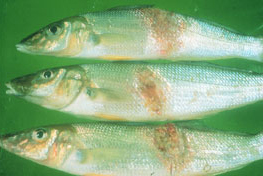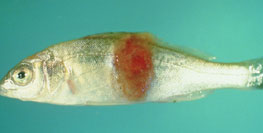Diseases of finfish
Fungal diseases—Epizootic ulcerative syndrome / red spot disease
CLICK ON IMAGE TO ENLARGE

Source: New South Wales Department of Primary Industries
CLICK ON IMAGE TO ENLARGE

Source: New South Wales Department of Primary Industries
Signs of disease
Important: animals with disease may show one or more of the signs below, but disease may still be present in the absence of any signs.
Disease signs at the farm level
- mass mortality
Disease signs at the tank and pond level
- mass mortality
Clinical signs of disease in an infected animal
- sores on body - red spots, black burn-like marks, or deeper ulcers with red centres and white rims
Gross signs of disease in an infected animal
- fungal hyphae (threads), sometimes extending into visceral organs
- liquefactive necrosis of muscle tissue
Disease agent
A fungus, Aphanomyces invadans, seems to be the primary cause of the disease, but other agents and water quality factors may also play a part in expression of the disease.
Host range
Fish known to be susceptible to epizootic ulcerative syndrome:
archer fish (Toxotes chartareus)
Atlantic menhaden* (Brevoortia tyrannus)
ayu* (Plecoglossus altivelis)
bagrid catfishes* (Bagridae)
barramundi* (Lates calcarifer)
carp* (Cyprinus carpio)
cichlids* (Cichlidae)
climbing perch* (Anabas testudineus)
cyprinids* (Cyprinidae)
dusky flathead (Platycephalus fuscus)
eel* (Anguilla australis)
flathead goby* (Glossogobius giurus)
Froggatt's catfish (Cinetodes froggatti)
giant glassfish* (Parambassis gulliveri)
giant gudgeon* (Oxyeleotris sp)
grey mullet* (Mugil cephalus)
mrigal* (Cirrhinus cirrhinus)
mullets* (Mugilidae)
nurseryfish (Kurtus gulliveri)
pool barb* (Puntius sophore)
rhinofishes* (Labeo spp)
rockcod* (Epinephelus tauvina)
scat (Scatophagus argus)
silver perch* (Bidyanus bidyanus)
silver trevally* (Pseudocaranx dentex)
snakeskin gourami* (Trichogaster pectoralis)
striped snakehead* (Channa striatus)
torpedo-shaped catfishes* (Clarius spp)
triangular shield catfish* (Arius leptaspis)
tropical two-winged flying fish* (Exocoetus volitans)
wels catfish (sheatfish)* (Silurus glanis)
whiting* (Sillago ciliata)
yellowfin bream* (Acanthopagrus australis)
* naturally susceptible (other species have been shown to be experimentally susceptible)
Presence in Asia–Pacific

EUS has been officially reported from Australia, Bangladesh, Burma (Myanmar), Cambodia, India, Indonesia, Japan, Laos, Nepal, Pakistan, the Philippines, Sri Lanka, Thailand and Vietnam.
Epidemiology
- The disease is seen in over a hundred freshwater and estuarine species of fish.
- It has often been associated with acid water run-off and can appear after heavy rains, particularly after a long dry period.
- Secondary bacterial and viral infections are often associated with this condition.
Differential diagnosis
The differential diagnostic table and the list of similar diseases appearing at the bottom of each disease page refer only to the diseases covered by this field guide. Gross signs observed might well be representative of a wider range of diseases not included here. Therefore, these diagnostic aids should not be read as a guide to a definitive diagnosis, but rather as a tool to help identify the listed diseases that most closely account for the gross signs.
Sample collection
Because of uncertainty in differentiating diseases using only gross signs, and because some aquatic animal disease agents might pose a risk to humans, you should not try to collect samples unless you have been trained. Instead, you should phone your national hotline number and report your observations. If samples have to be collected, the agency taking the call will advise you on what you need to do. Local or district fisheries/veterinary authorities could advise you on sampling.
Emergency disease hotline
For your national emergency disease hotline number, see Whom to contact if you suspect a disease.
Further reading
http://www.oie.int/aac/eng/cards/en_diseasecard.htm
http://www.enaca.org/Health/DiseaseLibrary/EpizooticUlcerativeSyndrome.pdf
The currently accepted procedures for a conclusive diagnosis of epizootic ulcerative syndrome are summarised at http://www.oie.int/eng/normes/fmanual/A_00027.htm
These hyperlinks were correct and functioning at the time of publication.

